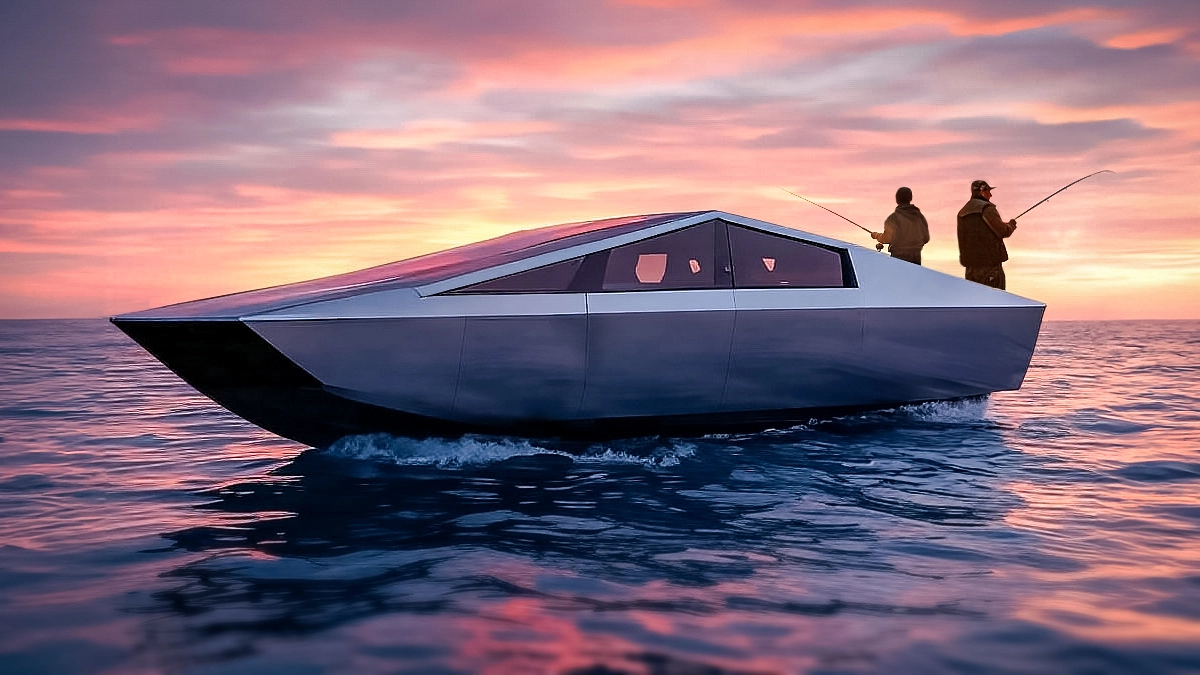Tesla is making waves with the introduction of the CyberBoat, a 21-foot long fishing vessel that promises to offer anglers improved performance in a quieter package. Like the other vehicles in Tesla’s lineup, the CyberBoat will be powered by an electric motor, which offers plenty of torque without the noise of an internal combustion engine. The new boat is said to be faster and more stealthy than anything before it. But that’s only part of the story.
Groundbreaking Propulsion System
“The unique thing about the CyberBoat,” said Tesla CEO Elon Musk, “is its ability to move in almost any direction, simply by manipulating the boat’s joystick. It makes piloting a boat easier than ever before. We think it will get more people into boating.”
Tesla’s engineers looked to the stars to make the unique vessel a reality. That is, they borrowed technology from SpaceX and applied it to a more down-to-earth scenario, though the propulsion system doesn’t rely on any explosive material. Instead, a high-powered electric motor drives a turbine, which simulates the thrust from the interstellar vehicles.
“We took what we learned from SpaceX’s booster rocket technology and turned it to boat motors,” said Musk. “The result is a series of passages that let us direct thrust in any direction, letting the CyberBoat move silently through cover frontwards, backwards, and every way between. And because of the instantaneous nature of electric motors, the boat can make countless adjustments per second. “

A Need for Speed
One of the benefits of electric power is torque that comes on hard and fast, leading to incredible launches. Zero to 60 times are said to be around 6.5 seconds, which is comparable to that of a hydroplane racing boat. While that much holeshot sounds good on paper, apparently it was a handful for those that don’t regularly partake in boat races.
“The CyberBoat was too powerful for the average driver,” said Musk. “So we had to take steps to make it a little more controllable.”
To make the boat more user-friendly, Tesla’s design team employed a “dynamic trim system.” A pair of these devices are located at the boat’s stern, and take input from the onboard gyroscope. As the bow climbs skyward, these automatically apply downward pressure. This keeps the boat level even when the throttle is cracked all the way open.
High-Tech Fishing Electronics
“The CyberBoat will set the standard for high-tech on the open seas,” says Musk.”We’ve taken legacy fishing technology beyond what the world has seen, and added some new capabilities thanks to our satellite network.”
Tesla is known for their cutting edge electronics, and the CyberBoat lives up to that reputation. The hull is outfitted with no less than eight transducers spread out along the bottom, which the company says leads to improved sonar returns. Four of the transducers, two in the bow and two in the stern, can rotate freely to provide both forward-facing and reverse sonar images for a total of 360-degree fishfinder coverage. The company believes this will lead to more hookups, and lets the boat more effectively map the lake bottom.
Speaking of maps, the vessel features a state-of-the-art navigation system that can receive real-time satellite data from Starlink, another of Musk’s companies, on lake surface temperatures, waves, and even weather forecasts. If you happen to be fishing a lake that doesn’t have contour mapping yet, the transducer network quickly provides a 3D picture of the bottom. And thanks to the satellite connectivity, you can easily share the new map with your buddies.
An impressive array of displays scattered throughout the boat gives anglers real-time feedback on all the information systems. Wherever they’re standing or sitting, they can get a look at the mapping, navigation, or sonar. Split screen capabilities provide multiple views at once, and a convenient touch-screen interface makes accessing all the features simple.
Next-Gen Trolling Motor
“On a traditional bass boat, you have a bow mounted trolling motor that moves you about while you cast,” Mush points out. “While this works, I find the arrangement to be a bit limiting. There’s definitely room for improvement, and I think we found that with the CyberBoat,”
And because the electric motor at the heart of the CyberBoat is infinitely adjustable, the throttle can be cranked up — or down — in the smallest of increments. This lets the central motor, in conjunction with the throttle passages, serve as a trolling motor of sorts. Combined with the vessel’s sophisticated navigation system and infinitely variable motor, the boat can follow a heading at just about any speed — just like the self-driving feature in Tesla’s automobiles.
This lets anglers troll plugs, precisely follow depth contours while handling a downrigger ball, or work the edges of structure or weedlines while the angler casts to likely spots. Downloading maps from the vast library lets the boat pilot itself along any feature you’d wish. The boat also has a “virtual anchor” mode, similar to Spot Lock. This lets it stay in place no matter how fast the wind is blowing.
Run Silent
“We wanted to give anglers every advantage we could,” said Musk. “Under water, sound travels four times faster than it does through the air. And it goes much further. So even if you turn off your outboard before you get close to the spot you want to fish, you’re still likely to spook some fish off. The CyberBoat won’t scare fish, because it’s basically silent.”
The near silent nature of the high performance vessel is expected to give tournament anglers an edge over their outboard-powered counterparts. But all this tech comes with a steep price tag, as base models are expected to retail for around $120k.
Musk is so confident in the boat’s abilities that he is offering a contingency payout to professional fishermen looking to be early adopters of the new tech.
“For the six months after the CyberBoat’s introduction, I will offer tournament anglers an additional $10,000 for each podium finish in a major event,” said Musk.
Battery Power
If all that sounds great, get ready for the but. While the CyberBoat has similar battery capacity as the Model Y, which delivers approximately 300 miles of range, the boat is decidedly more limited. The problem lies in the lack of regenerative braking that cars rely on to repower their batteries on the go. When the brakes are applied, they turn an alternator of sorts that charges the battery.
“Unfortunately, the range of the boat is a bit limited at this time,” says Musk. “Moving around on the water requires a lot of energy,, and we haven’t figured out a way to recoup any of that yet. But we’re working on ways to turn the turbine into a generator when it’s not in use for propulsion, but we’re not sure how useful it will be frankly — unlike a road, water is in constant motion.”
For more info on the CyberBoat, check out the launch website here.




![[VIDEO] How to Install the Garmin Force Pro Trolling Motor](https://www.wired2fish.com/wp-content/uploads/2025/06/trolling-motor-install-300x169.webp)











